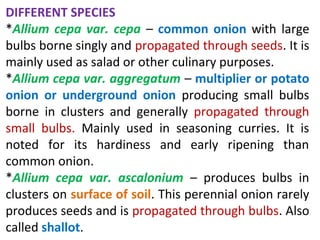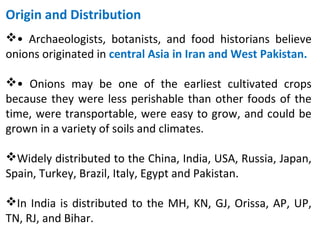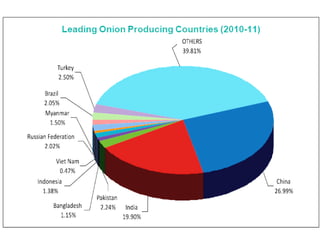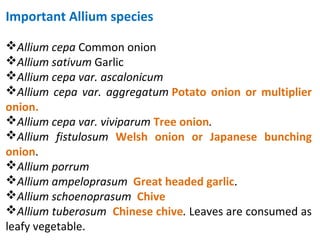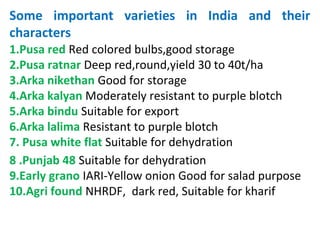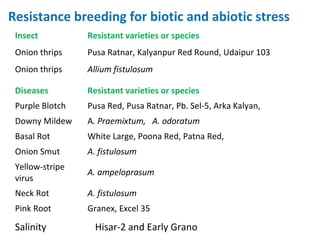Onion and garlic
- 2. Onion (Allium cepa L.) 2n=16 Family- Amaryllidaceae
- 3. Importance Onion - also known as the bulb onion or common onion is widely used as salad or cooked in various ways in all curries, fried, boiled or baked. Onion is also used in processed forms e.g. flakes, powder paste, pickles etc. It has very good medicinal value. The word onion comes from the Latin word unio, which means "single," or "one"— reflecting of the onion plant producing a single bulb, unlike its cousin, the garlic, that produces many small bulbs. The name also describes the onion bulb when cut down the middle; it is a union (also from unio) of many separate, concentrically arranged layers. Onions are high in vitamin C, a good source of fibre, and with only 45 calories per serving, add abundant flavour to a wide variety of food • Onions are sodium, fat, and cholesterol free, and provide a number of other key nutrients.
- 4. ODOUR OF ONION • The strong smell of the onion and its relatives contain thioallyl compound or alliins • When cut or crushed, the alliin within the onion is converted by an enzymatic reaction into allicin, this breaks down into sulfide compounds. • Sulfide compounds are aromatic and this is what gives the onion, and all the plants in the onion family, their distinctive smell.
- 5. DIFFERENT SPECIES *Allium cepa var. cepa – common onion with large bulbs borne singly and propagated through seeds. It is mainly used as salad or other culinary purposes. *Allium cepa var. aggregatum – multiplier or potato onion or underground onion producing small bulbs borne in clusters and generally propagated through small bulbs. Mainly used in seasoning curries. It is noted for its hardiness and early ripening than common onion. *Allium cepa var. ascalonium – produces bulbs in clusters on surface of soil. This perennial onion rarely produces seeds and is propagated through bulbs. Also called shallot.
- 6. Shallots – milder and subtle. Used in egg dishes and garnishes.
- 7. Allium cepa var. viviparum/proliferum – not widely cultivated, bulbs are produced in place of umbels and are used for pickling and seasoning. Also called tree onion and is noted for its resistance to virtually all known pests and diseases of onions. *Allium schoenoprasum or chives – this is a hardy perennial bunching herb grown for their hollow green leaves. It is propagated by root division. *Allium fistulosum – it is a perennial bunching species and is very common in China and Japan and is grown for its edible tops and leaf bases.
- 9. TYPES OF ONIONS CLASSIFICATION Onions vary in colour, size, the time of year harvested, and flavor. These differences make onions very versatile. The Colour of Onions I.Yellow Onions are full-flavored and are a reliable standby for cooking almost anything. Yellow onions turn a rich, dark brown when cooked and give French Onion Soup its tangy sweet flavour. II.Red Onions, with their wonderful colour, are a good choice for lots of fresh uses or for grilling and roasting. III.White Onions are often used in prepared salads, white sauces, and is the traditional onion for classic Mexican cuisine. They have a golden colour and sweet flavour when sautéed
- 10. SEASONAL CLASSIFICATION I. Spring/Summer Onion Traits FRESH ONIONS • Available in yellow, red, and white from March through August • Can be identified by their thin, lighter-coloured skin • Typically higher in water content, which reduces their shelf-life and makes them more susceptible to bruising • Range in flavour from sweet to mild • Best to use in salads, sandwiches, and fresh, lightly-cooked or grilled dishes • Many specialty sweet onions are part of this category and are sold under a specific trade name or label II. Fall/Winter Onion Traits STORAGE ONIONS • Available August through May in yellow, red, and white • Easy to recognize by their multiple layers of thick, darker coloured skin • Commonly lower in water content, they have a longer shelf-life • Range in flavour from mild to pungent • Best for savory dishes that require longer cooking times or more flavour
- 11. Origin and Distribution • Archaeologists, botanists, and food historians believe onions originated in central Asia in Iran and West Pakistan. • Onions may be one of the earliest cultivated crops because they were less perishable than other foods of the time, were transportable, were easy to grow, and could be grown in a variety of soils and climates. Widely distributed to the China, India, USA, Russia, Japan, Spain, Turkey, Brazil, Italy, Egypt and Pakistan. In India is distributed to the MH, KN, GJ, Orissa, AP, UP, TN, RJ, and Bihar.
- 12. Onions centre of origin Central Asia
- 15. Collection Sources of onion genetic resources in India National Bureau of Plant Genetic Resources, New Delhi Directorate of Onion and Garlic Research, Rajguru nagar, Pune, Maharshtra National Horticultural Research and Development Foundation, Nasik IIHR, Bangalore IARI, New Delhi State Agriculture Universities
- 16. Important Allium species Allium cepa Common onion Allium sativum Garlic Allium cepa var. ascalonicum Allium cepa var. aggregatum Potato onion or multiplier onion. Allium cepa var. viviparum Tree onion. Allium fistulosum Welsh onion or Japanese bunching onion. Allium porrum Allium ampeloprasum Great headed garlic. Allium schoenoprasum Chive Allium tuberosum Chinese chive. Leaves are consumed as leafy vegetable.
- 17. Breeding Objectives High yield Longer bulb storage life Resistance to diseases (purple blotch, basal rot, stem phyllium blight, bacterial storage rot) Resistance to pests(thrips) Resistance to abiotic stresses (moisture stress, high temperature, salinity and alkalinity) Bulb quality Size, shape, color, pungency, firmness, dormancy, amount of soluble solids. Dormancy is important because onions are normally stored for longer time. High TSS is important for dehydration industry production chips and powder.
- 18. Bolting resistant varieties Indian varieties pose problems of bolting and doubling of bulbs, especially in the September – October planting. There is a need to develop bolting resistant varieties for this season. Bolting is when an onion plant produces a flower stalk. Bolted onion bulbs stop growing; they must be harvested and consumed right away, as they can't be stored. At this point, the bulb stops growing altogether because the plant needs energy to make the flower stalk. Bolting is when an onion plant produces a flower stalk. Bolted onion bulbs stop growing; they must be harvested and consumed right away, as they can't be stored. At this point, the bulb stops growing altogether because the plant needs energy to make the flower stalk.
- 19. S.No. Breeding Method Varieties 1. Plant introduction Early Grano, Brown Spanish 2. Selfing and massing Pusa Madhvi 3. Mass selection Arka Niketan, Arka Kalyan, Agrifound Light red, Bhima Shweta, Pusa Red, Pusa Ratnar, N-2-4-1, Agrifound Dark Red, Arka Pragati, Kalyanpur Red Round 5. Heterosis Breeding Arka Kirtiman, Arka Lalima, Arka Pitamber 6. Pedigree CO 5 Varieties/hybrids developed by different methods
- 20. 1.Pusa red Red colored bulbs,good storage 2.Pusa ratnar Deep red,round,yield 30 to 40t/ha 3.Arka nikethan Good for storage 4.Arka kalyan Moderately resistant to purple blotch 5.Arka bindu Suitable for export 6.Arka lalima Resistant to purple blotch 7. Pusa white flat Suitable for dehydration 8 .Punjab 48 Suitable for dehydration 9.Early grano IARI-Yellow onion Good for salad purpose 10.Agri found NHRDF, dark red, Suitable for kharif Some important varieties in India and their characters
- 21. Quality parameters for dehydration Some essential characteristics are White coloured flesh Total solid content 15–20% High pungency Ratio of reducing to non-reducing sugar should be low Resistance to diseases, moulds and insects Other quality parameters Quercetin, Total phenolics and Ascorbic acid
- 22. Biochemical compounds Range Promising genotypes TSS (0 B) 15-20 Sel-126, Red Creole Udaipur- 102, Pusa White Round, Pusa White Flat Quercetin (mg/100g) 6.01- 109.78 Sel-397, Burgundy and Sel-383 Total phenolics (mg/100g) 22.36- 94.14 I-33, Sel-397 and I-25 Ascorbic acid (mg per 100 gm) 9.74- 84.23 Sel-383, I-40 and Burgundy Promising Selections of Onion for different quality parameters
- 23. Diseases Resistant varieties or species Purple Blotch Pusa Red, Pusa Ratnar, Pb. Sel-5, Arka Kalyan, Downy Mildew A. Praemixtum, A. odoratum Basal Rot White Large, Poona Red, Patna Red, Onion Smut A. fistulosum Yellow-stripe virus A. ampeloprasum Neck Rot A. fistulosum Pink Root Granex, Excel 35 Insect Resistant varieties or species Onion thrips Pusa Ratnar, Kalyanpur Red Round, Udaipur 103 Onion thrips Allium fistulosum Salinity Hisar-2 and Early Grano Resistance breeding for biotic and abiotic stress
- 24. LIST OF ONION VARIETIES Red Coloured Bulbs Punjab Selection Pusa Ratnar Pusa Red N2-4-1 Pusa Madhavi Arka Niketan Agrifound Dark Red Kalyanpur Red Round Agrifound Light Red Hisar 2 Punjab Red Round Arka Pragati N-53 Baswant-780 Udaipur-101 Arka Kalyan Bhima Super Bhima Raj Bhima Red Upaipur-103 Line-28 Phule Samarth Yellow Coloured Bulbs Early Grano Spanish Brown Phule Suvarna White Coloured Bulbs Pusa White Round Pusa White Flat Punjab-48 Udhaipur-102 N-257-9-1 Phule Safed Agrifound White Agrifound Rose Akra Bindu Multiplier Onion Co-1 Co-2
- 25. Garlic (Allium sativum L.) 2n=16 Family- Amaryllidaceae Other names- Lehsun and wonder food Center of origin- Central Asia Mode of pollination- Cross pollinated
- 26. Importance Garlic is frost hardy bulbous erect herb. The bulb consists of 6-35 smaller bulblet is called ‘cloves’ which is used as spice. Garlic is good source of amino acids and protein. Garlic contains amino acid called allin. The enzyme allinase converts allin into allicin. Allicin is the anti-bacterial substances of garlic and has the typical odour of fresh garlic.
- 27. Has been used for medicinal purpose since ancient times Antibiotic action Reduces cholesterol and blood pressure Prevents stomach cancer Has wound healing potential Feasibility as pesticide i.e. garlic extract with mineral oil, water and liquid soap Antibacterial effect Application of Aged Garlic Extract (AGE reduces severity of P. infestans in tomato and Cucumber downy mildew (P. cubensis) Pungency is due to Diallyl disulphide (60%) and Allyl- propyl disulphide (20%).
- 28. Subspecies of A. Sativum There are two subspecies of sativum A. sativum var. Ophioscorodon - hard necked garlic A. sativum var. Sativum - soft-necked garlic Wild species A. longicuspis Regel, was considered by taxonomists as the closest relative to, or ancestor of the domesticated garlic.
- 30. Garlic in History Garlic is among the oldest known horticultural crops. In the Old World, Egyptian and Indian cultures referred to garlic 5000 years ago and there is clear historical evidence for its use by the Babylonians 4500 years ago and by the Chinese 2000 years ago. Garlic grows wild only in Central Asia (centered in Kyrgyzstan, Tajikistan, Turkmenistan, and Uzbekistan) today. Central Asia is referred to as its "center of origin”. Allium vineale is a wild relative of garlic that occurs in North America and is commonly called "wild garlic".
- 31. Breeding objectives High yield Larger bulb size Bulb quality- white colour, high pungency and compact cloves Resistance to diseases (Mosaic, purple blotch and Stemphylium blight) Resistance to insect-pest (Mite, aphid and thrips) Longer storage life
- 32. S.No . Breeding Method Varieties 1. Mass selection Agrifound White (G-41), Yamuna Safed (G-1), Yamuna Safed-2 (G-50), Yamuna Safed-3 (G-282), Yamuna Safed-4 (G-323) 2. Clonal selection Gujarat Garlic-2, Gujarat Garlic-3 Breeding methods and developed varieties
- 33. Diseases Tolerant Purple Blotch Yamuna Safed, Agrifound Parvati Stemphylium Blight Yamuna Safed, Agrifound Parvati Insect Onion Thrips Yamuna Safed Resistance breeding for biotic stress
- 34. Agrifound White NHRDF, Nasik Bulb diameter 3.5-4.5 cm, 20-25 cloves/bulb, susceptible to purple blotch and stemphylium blight, TSS-41%. Yamuna Safed NHRDF, Nasik 25-30 sickle shaped cloves, diameter 4.0-4.5 cm, tolerant to thrips, purple blotch and stemphylium blight, TSS-38%. G-282 NHRDF, Nasik Bulbs are creamy white and big size (5-6 cm diameter), having 15-16 cloves/bulb, TSS-38-42%, suitable for export purposes. Agrifound Parvati (G-313) NHRDF, Nasik Long-day type, bulbs are of bigger size (5-6 cm diameter), 10-16 cloves/bulb, tolerant to common diseases, suitable for export. Bhima Omkar DOGR, Rajguru Nagar, Pune Average yield of the variety is 107 q/ha. Bhima Purple DOGR, Rajguru Nagar, Pune The bulbs are purple in colour with TSS 33.6% and allicin @ 2.9 mg/g (fresh weight basis) and 9.6 mg/g (dry weight basis). Pant Lohit G.B.U.A.&T., Pant Nagar Moderately resistant purple blotch. Bulbs are compact and bold weighing 18-20 g. There are15-18 cloves per bulb. Important Varieties and varietal characterization
- 35. Directorate Of Onion And Garlic Research (DOGR) Rajguru Nagar, Pune, Maharashtra
- 36. National Horticultural Research and Development Foundation, NASHIK





